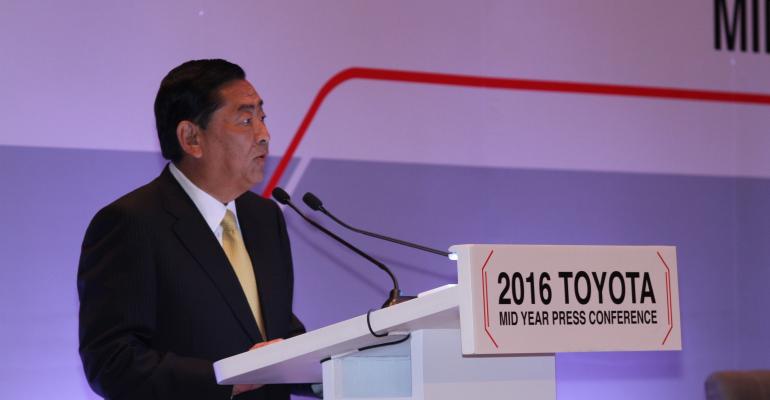BANGKOK – The difficult period for the Thai market, which has been declining since a new-car incentive scheme expired more than three years ago, continues to be hampered by a flat economy and a wider global slowdown that has had an add-on effect in reducing export demand.
However, Toyota Motor Thailand, briefing the media during its traditional half-year backgrounder here, sees green shoots for the domestic market, although improvements aren’t likely to be seen before 2017.
After a flat first half of the year, the automaker, which dominates the Thai landscape with an almost one-third market share, projects full-year industry sales to come in at around 740,000 vehicles, 7.5% down from last year.
That figure is better than had been expected, though, as Toyota previously had predicted total market sales of only 720,000 units this year.
Toyota Motor Thailand President Kyoichi Tanada blames the struggling domestic market on “the (Thai) economic slowdown, together with an unstable global economic outlook.”
However, he credits the Thai government’s “support and measures that stimulate national economic growth” for limiting the new-vehicle sales slide.
While Tanada admits it’s “turning out to be another tough year,” he expects further key stimulus measures to give the market a kick going forward, especially the big infrastructure projects already in the pipeline.
“The outlook for sales is positive in some respects, we expect positive impacts from tourism and the service industry, as well as continued spending by the government to stimulate investments from the private sector and new entries by various carmakers which will positively affect the outlook for the national economy and the Thai auto market,” he says.
However, Tanada warns the “ongoing economic slowdown, limited purchasing power and an unstable global economic outlook” are going to hold the market back at least until next year.
“It will be sometime before we see a recovery,” he says, warning the auto industry will need continued government support if both domestic and export demand are to increase.
Tanada emphasizes the role Thailand plays in Toyota’s global picture.
“Thailand is regarded as one of the most significant production hubs in this region,” he says, noting Toyota is continuing to push localization and technology transfer. He points out the automaker’s local engine operation in May passed the 10 million-unit mark in cumulative production, the making it one of two plants outside of Japan (along with Georgetown, KY) to have done so.
Not Charged Up About EVs
The Thai government recently accelerated plans for EV production, which has caused some concern within the local industry. Toyota remains noncommittal about this strategy, with executives here saying they do not feel the local market is ready for this ambitious new direction.
EV investment is expected to come only gradually. Hybrid vehicles, which Toyota produces locally, are the better bet and will represent “a further platform for the development of (the) EV,” Tanada says. He emphasizes the automaker’s commitment to hybrid production here.
“We will introduce new hybrid models (and) we confirm going forward to produce hybrids (in Thailand).”
Toyota’s Thai factories are running at 60%-70% capacity, equating to production of just over 600,000 units this year. With 60% of production capacity slated for export, the global economic picture, in particular the downturn in its key export market of the Middle East, has hit Toyota hard here.
“This has impacted our exports, as orders from this region have dropped significantly,” Tanada says, adding he expects total exports to plunge 17% this year to 312,000 units.
However Toyota is upbeat it can reverse the production decline. “We will try to produce to 800,000 units,” Tanada says.
With the reduction in production, Toyota recently has introduced a staff-redundancy scheme. “We estimate that 900 people will be enough (voluntary redundancies),” Tanada says. “(The offer has) been very well received, more than 1,000 applied to leave.”
The scheme has been closed to applicants and Toyota doesn’t expect to have to extend it – though it is leaving the door open slightly. “If the situation isn’t going to be worse than now, we won’t have any more redundancies,” Tanada says. “But if the future is worse, maybe (there will be job cuts).”
Toyota’s first-half sales totaled 109,078 units, down 11.4%. While commercial-vehicle deliveries, including pickups, rose, the car portfolio took a hammering. The 30%-plus drop in that sector is attributed to a halt in production of the key, B-segment Vios.
“During the first four months we had a Vios production halt,” he says. “So the Vios comes back in the second half (and) we think we can achieve sales targets of 240,000 units.”
The Vios model is being offered in new special-edition variants (dubbed “Exclusive”), and a marketing campaign for them is under way.
The revamped Vios is expected to help Toyota in its effort to reclaim the No.1 spot the car segment. “We have to try our best to take the leadership position in the market,” Tanada says.
Toyota also will introduce the new second-generation Sienta this month. This 3-row, 7-seat model 1.5L multipurpose vehicle is based on the Vitz subcompact car and is being assembled in Indonesia. Its closest market rival is the Honda Freed.
Meanwhile, a new assembly plant planned for Malaysia will be aimed at serving the local market only and won’t impact Thailand’s role as Toyota’s regional export hub, Tanada says.
“Production capacity is only 50,000 units to help create a working environment,” he says. “Malaysia is not about export.”
While the Malaysian new-car market is struggling, Toyota is looking toward the future by putting extra capacity in place, he adds.
“The current plant is only 80,000 units (capacity), and in the future there will be growth in the Malaysian market,” he says. “So 80,000 won’t be enough; we (need) a second plant.”
The total capacity of 130,000 for the two plants will put Toyota ahead of rival Honda, which has capacity for about 100,000 vehicles in Malaysia.





